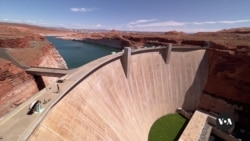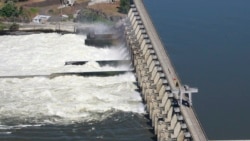ການປ່ຽນແປງຂອງດິນຟ້າອາກາດ ແມ່ນເຮັດໃຫ້ການສະໜອງນ້ຳ ຢູ່ຕາມແມ່ນ້ຳສາຍຕ່າໆ ຂອງໂລກບໍ່ສາມາດຄາດຄະເນໄດ້. ສິ່ງນັ້ນເຮັດໃຫ້ມັນມີຄວາມທ້າທາຍນັບມື້ນັບເພີ່ມຂຶ້ນ ໃນການຈັດການເລື້ອງຄວາມຕ້ອງການນໍ້າສູງຂອງຕົວເມືອງ, ຂອງຟາມ ແລະເຄື່ອງຜະລິດໄຟຟ້ານ້ຳຕົກຕ່າງໆ. ການຈໍາລອງຄອມພິວເຕີຊ່ວຍໃຫ້ຜູ້ຈັດການເລື້ອງ ນໍ້າສາມາດຕັດສິນໃຈໄດ້. Matt Dibble ມີລາຍງານເລື້ອງນີ້ໃຫ້ພວກເຮົາຢູ່ໃນລາຍການ LogOn ສໍາລັບມື້ນີ້ ຊຶ່ງບົວສະຫວັນຈະນໍາມາສະເໜີທ່ານໃນອັນດັບຕໍ່ໄປ.
ເຂື່ອນຫລາຍໆແຫ່ງ, ອ່າງເກັບນ້ຳ ແລະ ຂໍ້ຕົກລົງທາງກົດໝາຍ ຫຼາຍໆ ສະບັບໄດ້ຫັນເອົາແມ່ນ້ຳໂຄໂລຣາໂດ ໃຫ້ກາຍເປັນລະບົບນ້ຳ ທີ່ມີຄວາມສະຫລັບຊັບຊ້ອນສູງທີ່ຮອງຮັບຄວາມຕ້ອງການປະຊາຊົນຫຼາຍກວ່າ 40 ລ້ານຄົນ ໃນພາກຕາເວັນຕົກສຽງໃຕ້ຂອງອາເມຣິກາ.
7 ລັດຢູ່ໃນສະຫະລັດ, ສອງລັດໃນເມັກຊິໂກ, ແລະ ຊົນເຜົ່າດັ້ງເດີມໃນ 30 ເຂດ ລ້ວນແຕ່ມີສິດໃຊ້ນ້ຳ ຢູ່ໃນແມ່ນ້ຳສາຍຕ່າງໆນັ້ນ.
ລະບົບທີ່ວ່ານີ້ ແມ່ນຂຶ້ນກັບການປ່ອຍນໍ້າຢ່າງກົງກັັບເວລາທີ່ແນ່ນອນ ອອກມາຈາກອ່າງເກັບນໍ້າສອງແຫ່ງ ທີ່ໃຫຍ່ທີ່ສຸດໃນສະຫະລັດ, ນັ້ນກໍຄືທະເລສາບມີດ (Mead) ແລະທະເລສາບພາວ (Powell). ບັດນີ້, ການປ່ຽນແປງຂອງດິນຟ້າອາກາດທີ່ຮຸນແຮງກໍາລັງເຮັດໃຫ້ການຈັດການແມ່ນໍ້າຕ່າງມີຄວາມທ້າທາຍຫຼາຍຂຶ້ນ.
ທ່ານນາງ ເອດິດ ຊະກອນນາ (Edith Zagona) ນໍາພາທີມງານຂອງມະຫາ ວິທະຍາໄລ ໂຄໂລຣາໂດ ທີ່ພັດທະນາຣີເວີແວ (RiverWare) ຊຶ່ງເປັນ ໂປຣແກຣມສ້າງແບບຈໍາລອງສະແດງໃຫ້ເຫັນວ່ານໍ້າຈະເປັນແນວໃດຖ້າພາຍໃຕ້ສະຖານະການຕ່າງໆ ທີ່ແຕກຕ່າງກັນ.
ທ່ານນາງຊະກອນນາ ນັກຄົ້ນຄວ້າ ຈາກມະຫາວິທະຍາໄລໂຄໂລຣາໂດເມືອງບາວເດີ້ກ່າວວ່າ:
"ພວກເຮົາໄດ້ຂະຫຍາຍມັນອອກ, ແລະພວກເຮົາສາມາດເຫັນທະເລສາບພາວ (Powell) ທີ່ສໍາຄັນຫຼາຍ ແລະມັນມີຂະບວນການປ່ຽນແປງທາງດ້ານວັດຖຸ ແລະຂໍ້ມູນທັງຫມົດທີ່ກ່ຽວຂ້ອງກັບທະເລສາບພາວອີກດ້ວຍ."
ການຄາດຄະເນດິນຟ້າອາກາດ, ອັດຕາການລະເຫີຍ, ການຜະລິດພະລັງງານ – ແລະປັດໄຈອື່ນໆທັງຫມົດທີ່ມີຜົນກະທົບຕໍ່ນໍ້າໃນຂະບວນການໄຫຼຂອງມັນແມ່ນລວມຢູ່ໃນຕົວແບບທີ່ວ່ານີ້.
ອົງການຂອງລັດຖະບານກາງ ທີ່ຈັດການເລື້ອງນໍ້າ ແມ່ນໃຊ້ໂປຣແກຣມ RiverWare ເພື່ອສ້າງສະຖານະການຕ່າງໆເຊັ່ນວ່າ ນໍ້າຈະປະຕິບັດການແນວໃດໃນປີທີ່ມີໄພແຫ້ງແລ້ງຫຼາຍ.
ທ່ານນາງຊະກອນນາກ່າວອີກວ່າ:
"ຄວາມສາມາດເພິ່ງພາອາໄສໄດ້ຂອງທະເລສາບພາວແມ່ນຫຍັງ ກໍແມ່ນການທີ່ສາມາດປ່ອຍນໍ້າຂອງມັນໄປໃຫ້ຜູ້ໃຊ້ນໍ້າທີ່ຂັດສົນທີ່ສຸດຢູ່ເຂດລຸ່ມຂອງແມ່ນໍ້າ?"
ການເຮັດໃຫ້ຜູ້ໃຊ້ນໍ້າທັງຫມົດເຫັນພ້ອມນໍາກັນກ່ຽວກັບວ່າ ຈະແບ່ງປັນນໍ້າແນວ ໃດອາດຈະເປັນເລື່ອງຍາກ. ຜູ້ມີສ່ວນຮ່ວມສ່ວນໃຫຍ່ທີ່ປັດຈຸບັນນີ້ໃຊ້ໂປຣແກຣມ RiverWare ແລະເວທີດຽວກັນ ໄດ້ຊ່ວຍຜ່ອນຄາຍການເຈລະຈາບາງອັນໄດ້.
ທ່ານເຈນນີເຟີ ກີມໂບລ (Jennifer Gimbel) ຈາກສູນກາງນໍ້າໂຄໂລຣາໂດໄດ້ຊ່ວຍເຈລະຈາຂໍ້ຕົກລົງກ່ຽວກັບແມ່ນໍ້າໂຄໂລຣາໂດ.
ທ່ານນາງກີມໂບລ, ນັກວິຊາການນະໂຍບາຍຢູ່ສູນກາງນໍ້າໂຄໂລຣາໂດກ່າວວ່າ:
"ຖ້າຢ່າງຫນ້ອຍພວກເຮົາສາມາດເຫັນພ້ອມກັນວ່າຄວາມເປັນຈິງ - ແລະນັ້ນກໍຄືສິ່ງທີ່ເກີດຂຶ້ນເມື່ອພວກເຮົາເລີ່ມເຮັດວຽກກັບເມັກຊິໂກ, ເຂົາເຈົ້າມີລະບົບຂອງເຂົາເຈົ້າເອງ, ພວກເຮົາກໍມີລະບົບຂອງພວກເຮົາ. ພວກເຮົາເລີ່ມໂຮມກັນ ແລະວາງຕົວແບບຮ່ວມກັນ. ມັນສຳຄັນຫຼາຍ.”
ຊອບແວທີ່ວ່ານີ້ຍັງຊ່ວຍຜູ້ທໍາການຕັດສິນໃຈທັງຫຼາຍກ່ຽວກັບແມ່ນໍ້າອື່ນໆ ນັບແຕ່ແມ່ນໍ້າໂຄລໍາເບຍ ຈົນຮອດ ຫາແມ່ນໍ້າໄນໄດ້ອີກດ້ວຍ.
ອ່ານລາຍງານເປັນພາສາອັງກິດຂ້າງລູ່ມນີ້:
Climate change is making water supplies more unpredictable along the world’s rivers. That’s making it increasingly challenging to manage the competing demands of cities, farms and hydropower generators. Computer simulations help water managers make decisions. Matt Dibble has our story in this week’s episode of LogOn.
A series of dams, reservoirs and legal agreements has turned the Colorado River into a highly complex water system supporting over 40 million people in the American southwest.
Seven U.S. states, two Mexican states, and 30 tribal nations all have rights to the river’s waters.
The system depends on precisely timed releases from the two largest reservoirs in the United States, Lake Mead and Lake Powell. Now, the extremes of climate change are making river management even more challenging.
Edith Zagona leads the University of Colorado team that developed RiverWare, a program that models how the river will function under different scenarios.
Edith Zagona, University of Colorado, Boulder, Research Professor:
“We’ve zoomed in, and we can see the very important Lake Powell, and it contains the physical processes and also all of the data associated with Lake Powell.
Climate predictions, evaporation rates, power generation – and all the other factors that impact the river on its journey are included in the model.
The federal agency managing the river uses RiverWare to run scenarios such as how the river will perform in a bad drought year.
Edith Zagona, University of Colorado, Boulder, Research Professor:
“What is the reliability of Lake Powell being able to release its water to those very needy water users downstream?”
Getting all the water users to agree on how to share can be difficult. Most stakeholders now use RiverWare, and the common platform has helped ease some negotiations.
Jennifer Gimbel, Colorado Water Center Policy Scholar:
“If we can at least agree to the facts – and that's what happened when we started working with Mexico, they had their system, we had ours. We started getting together and putting models together. It’s important.”
The software is also helping decision makers on other rivers, from the Columbia to the Nile.







ຟໍຣັມສະແດງຄວາມຄິດເຫັນ